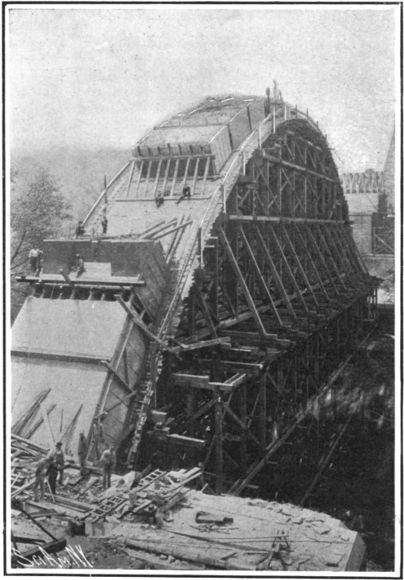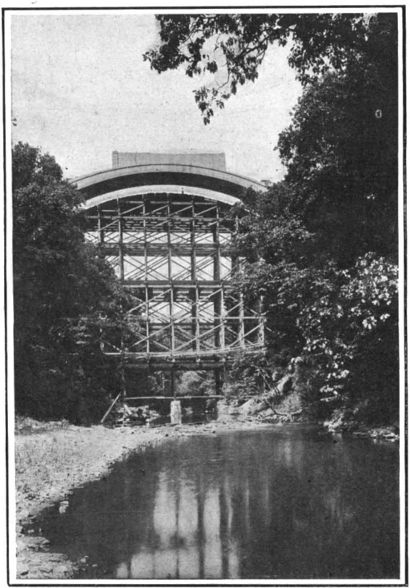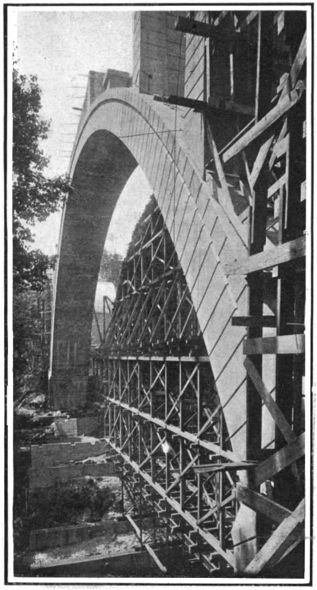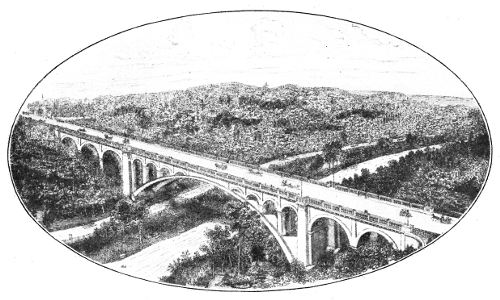The New Bridge Over the Wissahickon at Philadelphia.
By J. A. Stewart.
One of the most striking types of recent bridge engineering is that which is being constructed by the city of Philadelphia over the Wissahickon Creek in one of the most charming sections of Fairmount Park. The bridge is modeled after the beautiful Luxembourg bridge in the Duchy of Saxony, near the borders of Germany, and closely follows the graceful outlines of its foreign prototype. Work on the bridge is well advanced. It is expected that it will be opened for traffic early next year. By its construction, a somewhat sequestered section will be opened to general traffic, and a much-needed direct line of travel supplied from Germantown to Roxborough. The bridge in itself constitutes a noteworthy addition to the growing list of artistic, architectural viaducts of the United States.
The special features of the bridge are the heavy masses entering into its composition; the uncommon size of the great central span, the longest concrete arch in the world, and the third longest masonry arch of any description in existence; and the method of construction. The problems most difficult of solution centered about the weight of the structure, and the isolated section to which materials had to be transported. A total weight of 50,000 tons of concrete is represented in the construction, all of which great mass had to be hauled by wagon a distance of a mile and a quarter. The ribs on the arch rings alone weigh about 8,000 tons. Other difficulties to be encountered were involved in the great depth of the ravine, and the height of the bluffs, east and west, which are linked by the bridge.
The grade of approach from Germantown is 4½ feet per 100, descending Walnut Lane, necessitating a cut of about 20 feet. On the west side there has been considerable filling in to make the grades as easy as possible. The grade on the bridge is is 1½ feet per 100.
The magnificent semicircle of the arch, from which the wooden superstructure has recently been removed, rises to a height of 147 feet, towering above the tallest trees in the valley, and extends over the rocky bluffs, a clear span from pier to pier of 233 feet. The general plan of the bridge is that of twin supporting arch ribs, floored across the top; a plan followed through the five approach arches, as well as the main one.
Over each main arch rib the floor is carried on eight pairs of relieving arches. The entire length of the bridge is 585 feet. The span of the approach arches (of which two are on the east and three are on the west) is 53 feet each. The eight relieving arches are 20 feet clear. The main arch piers rise 80 feet above the water, and 100 feet above the rock.
Three segments of circles form the main arch. It has two ribs or rings, each 21 feet 6 inches wide and 9 feet 6 inches thick at the springing line, and 18 feet wide and 5 feet 6 inches thick at the crown. Each of these carries ten vertical cross walls. The spandrel arches, holding the spandrel walls, rest on piers supported by the main arch, and are also semicircular in form. They are 3 feet 6 inches wide and 1 foot 3 inches thick at the crown, decreasing from 2 feet at the spring. The thickness of the cross walls varies slightly, but in general approximates 2 feet. This variation constitutes the adjustment of the dead load on the arch made necessary by the varying height of the spandrel piers due to the grade of the roadway.
In the building of the main arch the usual order of construction was reversed. First, concrete was placed at the crown in order to consolidate the falsework. The arch was constructed in blocks, or loose voussoirs, distributed about over the falsework in order to spread the weight and prevent deformation of the falsework. The whole of the arch ring was thus placed until seventeen key spaces were left, which were scattered over the falsework to permit the complete compression of the falsework before the keying, or closing. By this means, the arch ring was not subject to any bending strains which would have existed under the old method of constructing arches, and which would have had a tendency to produce cracks.
When the voussoirs had fully shrunk and all settlement had taken place in the falsework, the seventeen keys were concreted as nearly at the same time as possible. After a period of thirty days, the centering was struck by slacking the wedges. This work proceeded from the middle toward each end. Eight men with sledges in six hours lowered the falsework sufficiently to free the arch. This was so successfully done as to cause a settlement of but 1/8 of an inch of the concrete at the crown of the arch.
As soon as the falsework was clear of the first arch rib, the anchor bolts which connected the transverse bents to the concrete falsework piers were removed. A 35-ton ball-bearing jack was set horizontally against the rear end of the bottom sill of each transverse bent of the falsework, or sub-structure, reacting against blocking secured by the anchor blocks in the concrete piers. The jacks were simultaneously operated by two men each, and pushed forward the falsework and substructure (having an estimated weight of 900 tons) on the rollers at the rate of 34 feet in three days. The voussoirs were then anchor-bolted to the concrete piers as at first, and the upper and lower sections of falsework raised on the wedges on both sides until the lagging was at the required position for the second arch rib. The concrete work was then continued as for the first rib.
 Falsework in Position, Showing Method of Construction. |  Side View, Showing the Splendid Arch. |  End View. Falsework Pushed Aside. |
Expansion joints are provided at each intersection of the spandrel walls with the cross-walls on the piers. These joints are locked with a tongue and groove 2 inches deep and the surfaces of the concrete separated by a layer of asbestos felt 1/8 inch in thickness. At the spring of every spandrel arch, is placed a strip of asbestos felt covering the front half of the ring, to accommodate the hinge action attending the rise and fall of the main arch because of temperature changes. The entire bridge is of concrete. Such steel as is used for reinforcement is deeply imbedded in the material, so that no metal is anywhere exposed to view. The bridge floor is carried on the spandrel walls; and is a combination of steel I beams, steel reinforcing rods, and concrete. The beams measure respectively 15 inches and 20 inches. The latter are riveted to the former and the 6-foot spaces between are filled with concrete forming jack arches. The floor of the bridge is paved with asphalt, 3½ inches of asphalt being placed on a 6-inch concrete base over a 12-inch layer of cinders and ¼-inch coating of coal tar. The driveway will be 40 feet wide between the curbs when completed, thus affording ample space for carriages outside the two car tracks which will cross the bridge. The sidewalks will be of granolithic construction, 8 feet wide, without obstructions in the shape of trolley or electric light poles along the steel-bound curbs. The parapets are openwork concrete balustrades of classic design.
The 884 balusters are the only parts of the structure not concreted in position. They measure about 23 inches long and 10 inches square, and are cast vertically in cast-iron molds at the rate of twenty daily by a gang of five men. When twenty-four hours old they are taken out of the mold and scrubbed, being afterward immersed in water for one week. In this way a very hard, smooth, gray surface is produced, with sharp corners. This surface closely resembles handsome cut-stone work, and does not crack nor chip. The bottom of the balusters is recessed to engage a projection in the coping to which it is bonded by a vertical steel dowel.
The reinforced concrete handrail is cast in position on top of the balusters. Asbestos felt filling is used in the expansion joints set between the ends of the 22-foot rails and the balustrade piers. In this way crushing and distortion are prevented. Similar means have been employed in other bridges built by the same designer.
The composition of the concrete used is 1 part cement, 2 parts coarse sand, 5 parts of ¼ to ¾ inch crushed stone; with imbedded flat stones of not less than one-man size placed radially close together. The surface of the concrete is cleaned so as to expose the grit and thus resembles stone in color and texture.
The cost of the construction is a little over a quarter of a million dollars.

